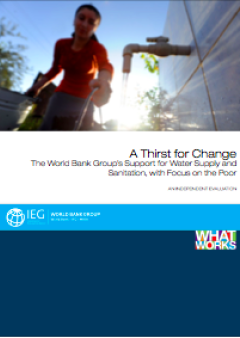
A Thirst for Change: An Evaluation of the World Bank Group's Support for Water Supply and Sanitation with Focus on the Poor
The state of water supply and sanitation access and services strongly influences human and economic development.
Global policy attention in the water and sanitation sector changed in 2015 from the Millennium Development Goals (MDGs) to the Sustainable Development Goals (SDGs). SDG 6 seeks to "ensure access to water and sanitation for all” by 2030. The MDG's primary concern is to provide access to water and sanitation services within a reasonable distance of a safe water supply source or hygienic sanitation facility. By contrast, SDG 6 has now raised the standards beyond access to more clearly defined requirements for equitable delivery, and to ensure adequacy, reliability, quality, and affordability of these services.
In moving to the higher standards for SDG6, many World Bank Group client countries face a difficult challenge in covering their large gaps in access to improved water and sanitation services while also improving service delivery.
The higher performance benchmarks of SDG 6 will need an investment estimated at $1.7 trillion in the next 15 years, which is three times historic levels—a difficult gap for many World Bank client countries to address given the sector's poor cost recovery record, dependence on public funds, and low and uncertain fiscal transfers
